De getoonde personages zijn echte patiënten en de vereiste toestemming om hun verhalen te gebruiken is verkregen van de patiënten en families. Foto's zijn uitsluitend bedoeld ter illustratie.
Types SMA
Klinische tekenen van spinale musculaire atrofie
Klik op de tabbladen om meer informatie over elk type te bekijken.
Hoogste motorische mijlpaal bereikt
KAN NIET ZELFSTANDIG ZITTEN
Levensverwachting
≤2 JAAR4
Type
Type I (ook gekend als de ziekte van Werdnig-Hoffmann)
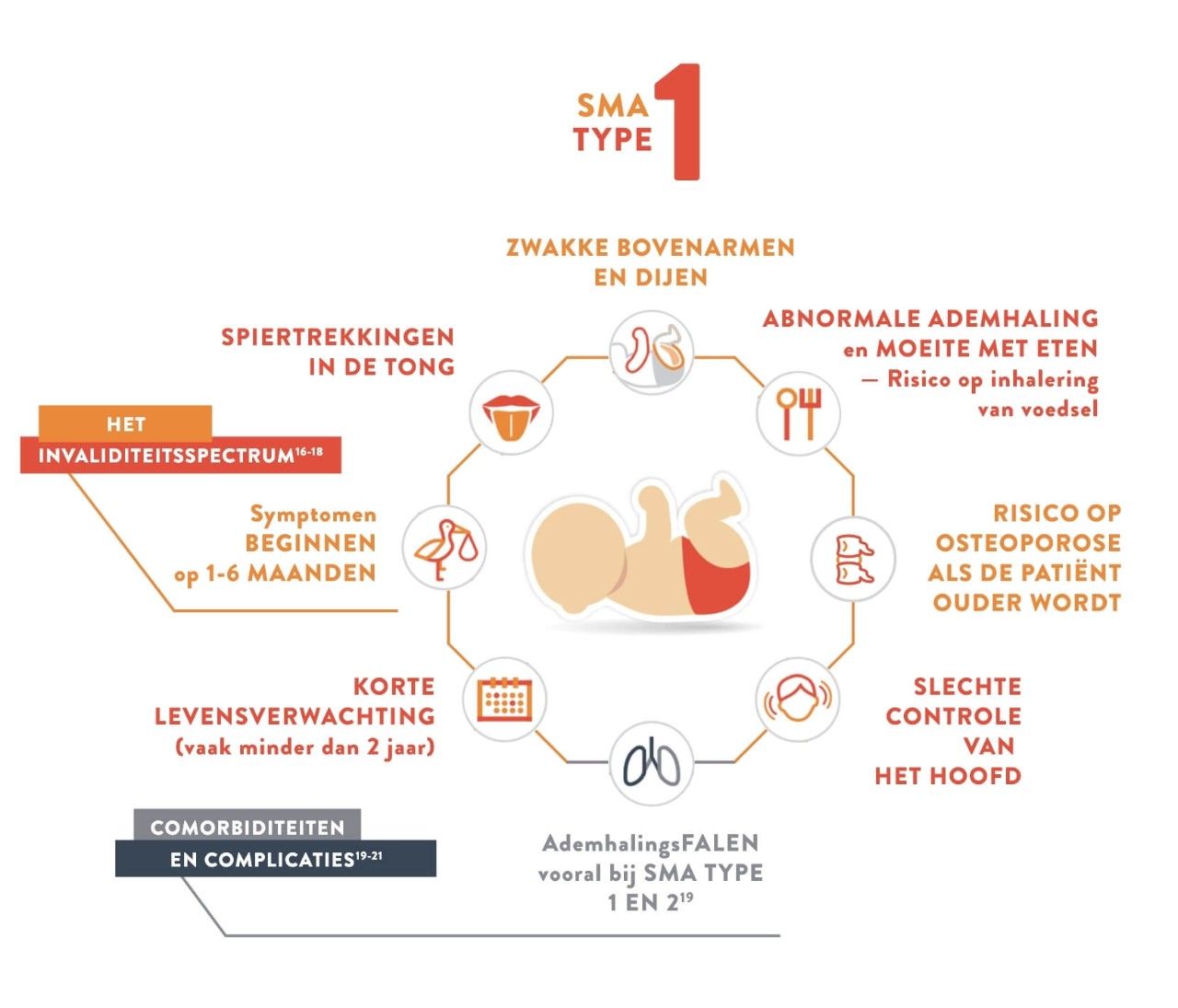

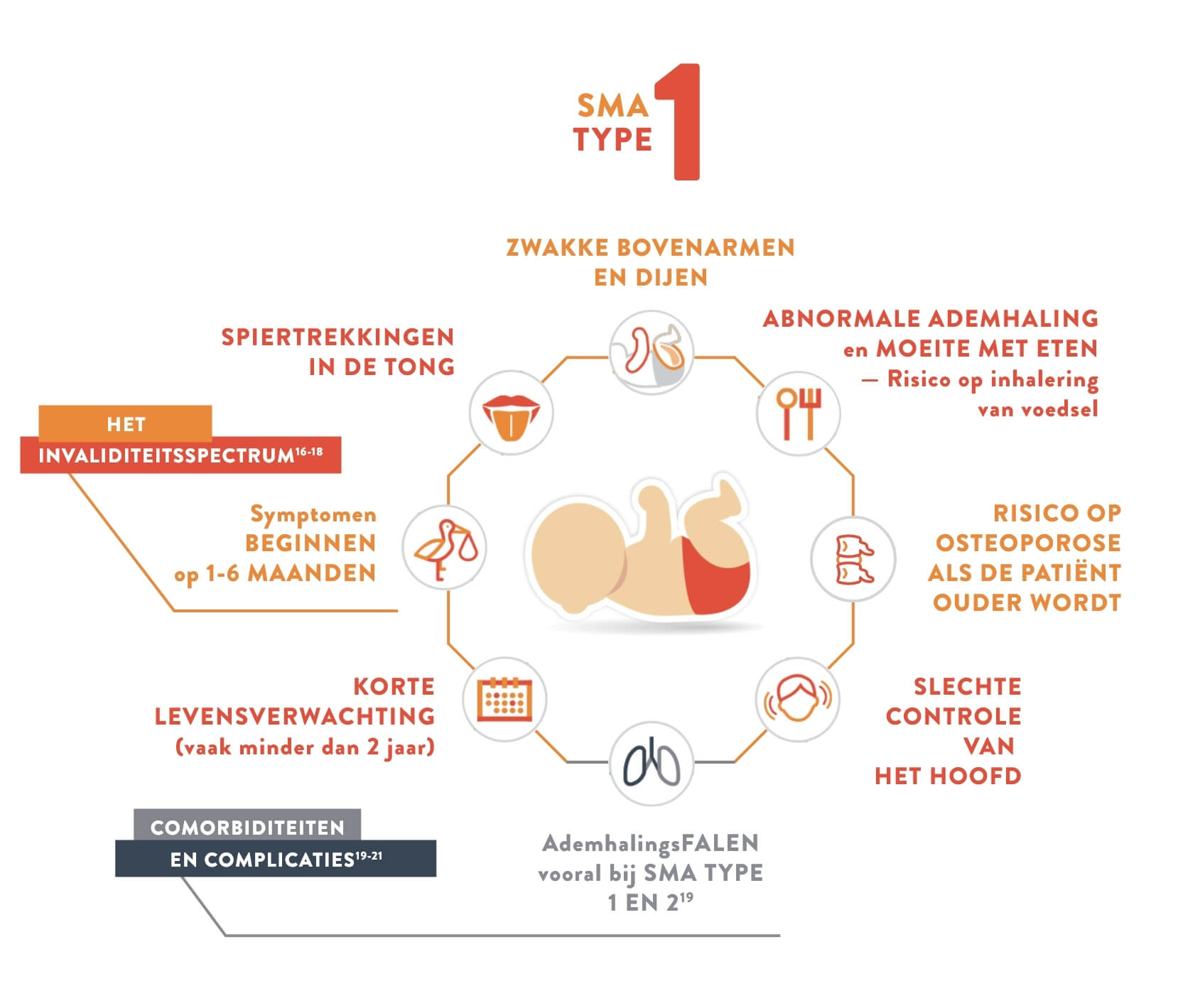
Klinische tekenen1,4,5-7
- Slechte controle van het hoofd
- Zwakke hoest
- Zwak huilen
- Progressieve zwakte van de spieren die gebruikt worden om te kauwen en slikken
- Zwakke spiertonus
- “Kikkerhouding” bij het liggen
- Ernstige spierzwakte aan beide zijden van het lichaam
- Progressieve zwakte van de spieren die helpen bij de ademhaling (tussenribspieren), wat resulteert in de karakteristieke “klokvormige” borst
- Risico op osteoporose als de patiënt ouder wordt
Hoogste motorische mijlpaal bereikt
KAN ZELFSTANDIG ZITTEN
Levensverwachting
>2 JAAR 70% LEEFT NOG OP DE LEEFTIJD VAN 25 JAAR
Type
Type II (ook gekend als het syndroom van Dubowitz)
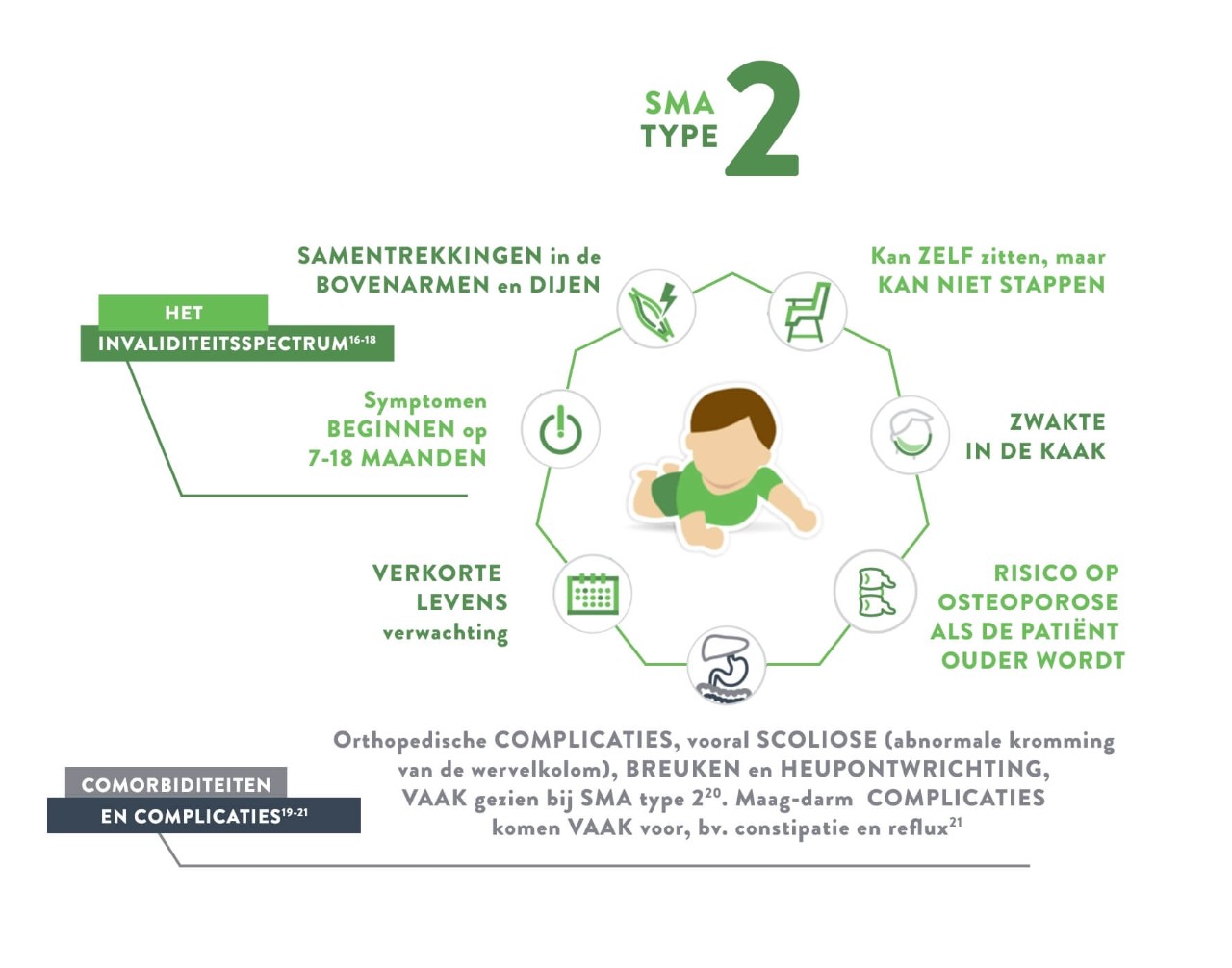

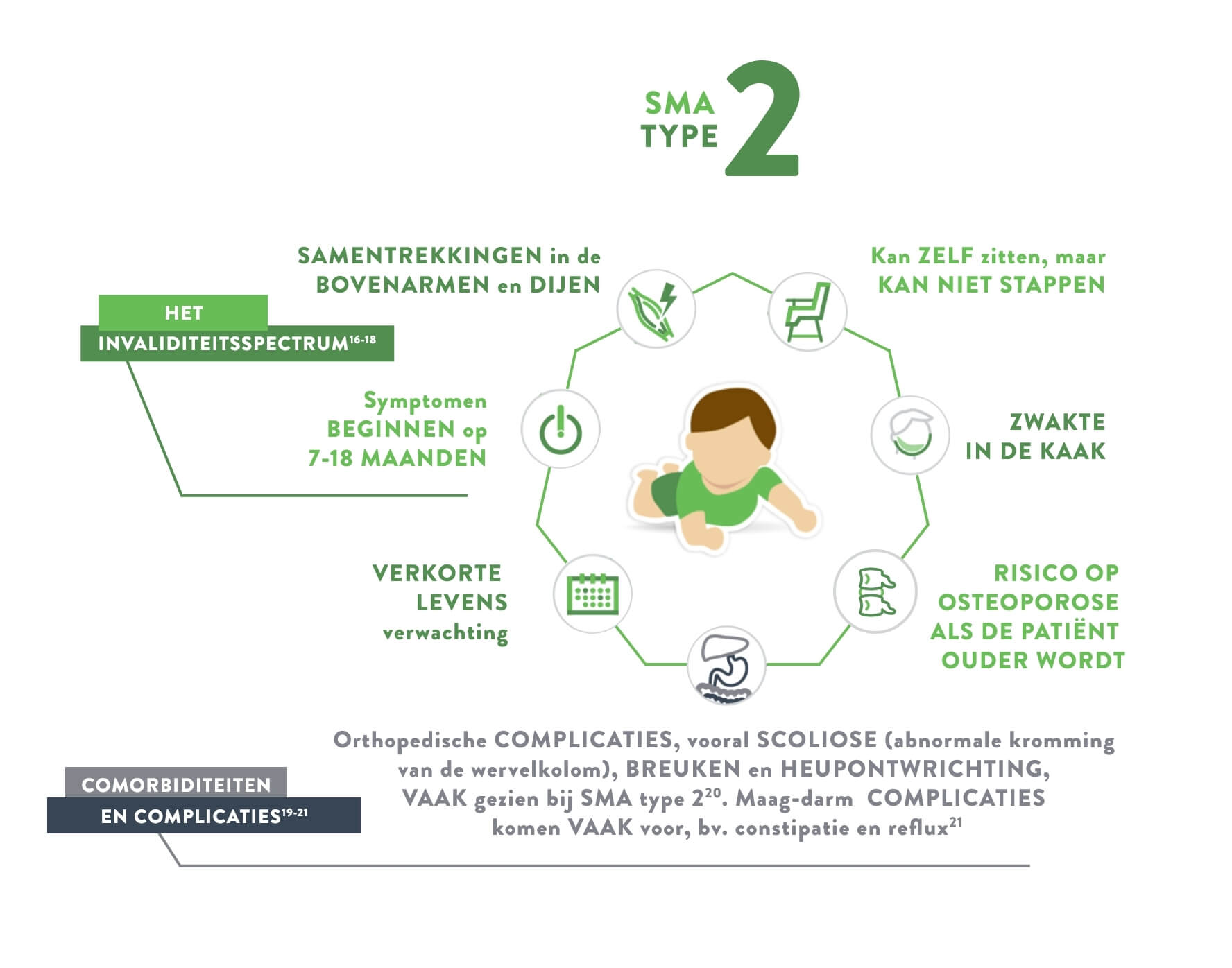
Klinische tekenen1,5
- Spierzwakte
- Problemen met slikken, hoesten en de ademhaling komen vaak voor wanneer deze patiënten ouder worden
- Symptomen van spierpijn en gewrichtsstijfheid
- De meeste kinderen met type 2 ontwikkelen rugproblemen zoals scoliose (kromming van de wervelkolom), waarvoor mogelijk braces (of spalken) of een operatie nodig zijn
- Risico op osteoporose als de patiënt ouder wordt
Hoogste motorische mijlpaal bereikt
KAN ZELFSTANDIG STAPPEN (hoewel dat vermogen geleidelijk aan verloren kan gaan)
Levensverwachting
NORMAAL
Type
Type III (ook gekend als de ziekte van Kugelberg-Welander)
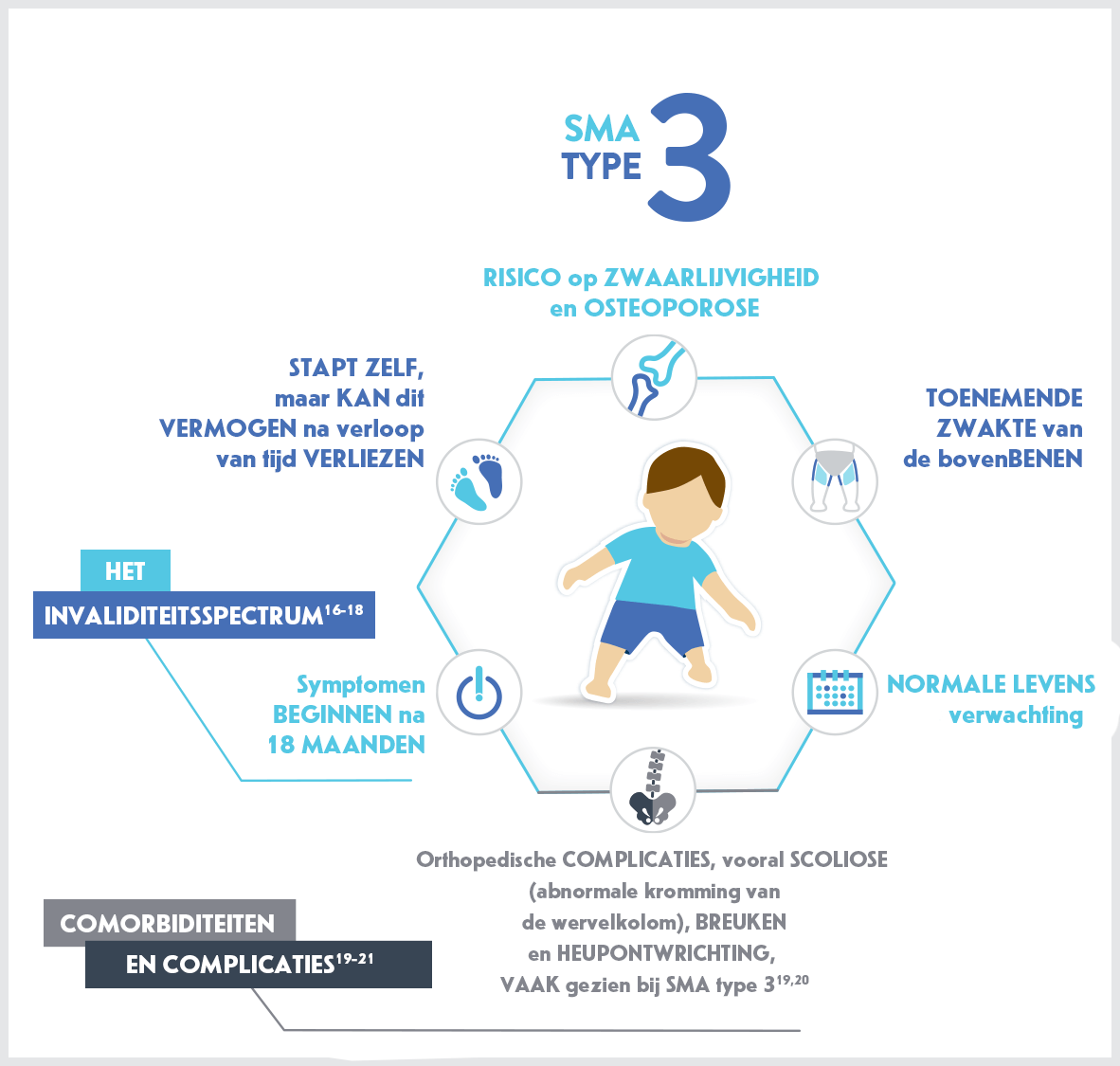

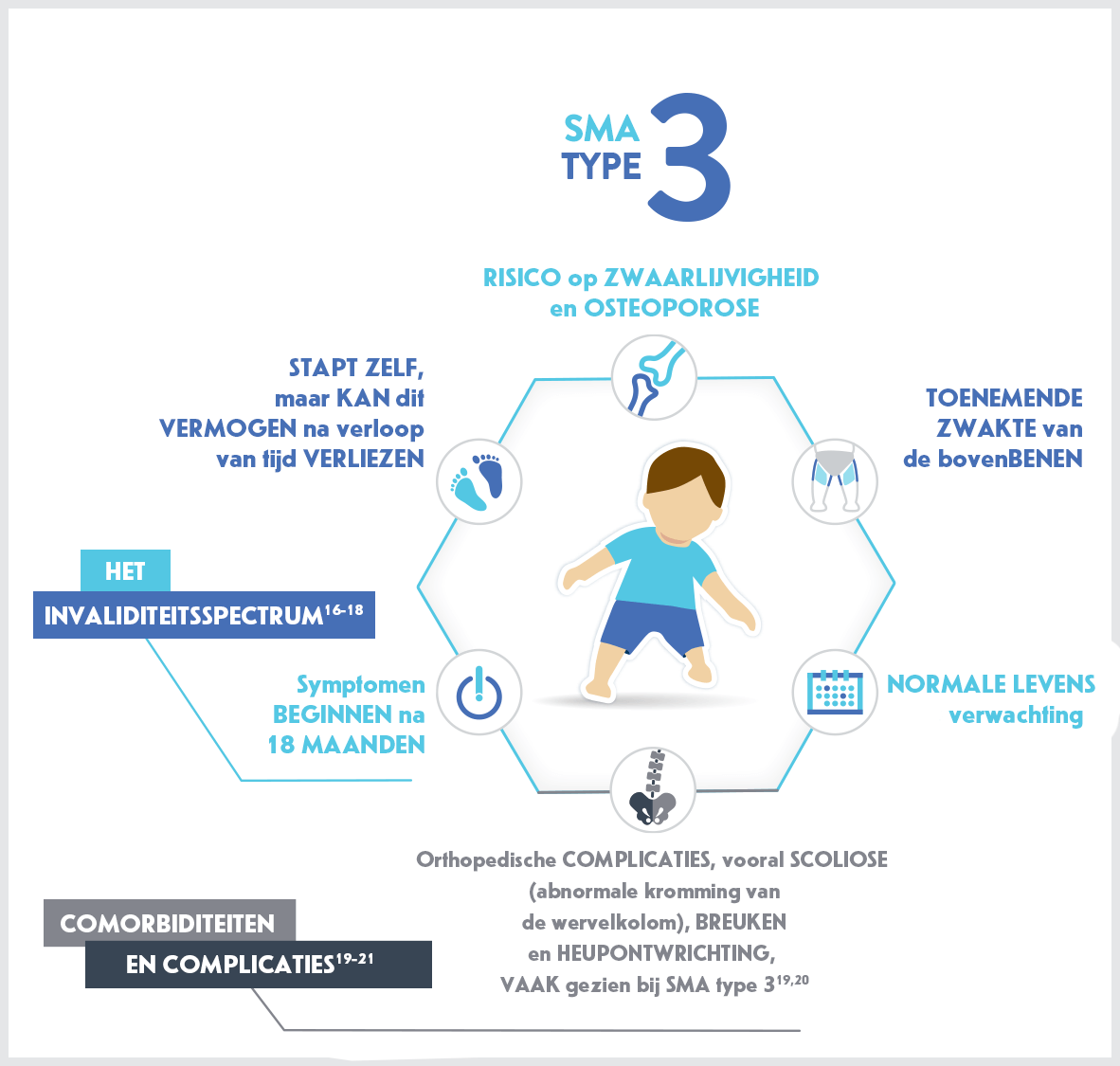
Klinische tekenen1,5
- Scoliose
- Problemen met kauwen en slikken
- Spieren in de benen zijn over het algemeen zwaarder getroffen dan de armen
- Spierpijn
- Symptomen van gewrichtsovergebruik
- Risico op osteoporose als de patiënt ouder wordt
Hoogste motorische mijlpaal bereikt
ALLES
Levensverwachting
NORMAAL
Type
Type IV
Klinische tekenen1,5
Lichamelijke symptomen zijn vergelijkbaar met de juveniele vorm van spinale musculaire atrofie, met geleidelijke aanvang van zwakte, tremor, en spiertrekkingen die voor het eerst opgemerkt worden in de late tienerjaren of de vroege volwassenheid
VERBINDEN
meer informatie over hoe u deel kunt uitmaken van de SMA-gemeenschap
De getoonde personages zijn echte patiënten en de vereiste toestemming om hun verhalen te gebruiken is verkregen van de patiënten en families. Foto's zijn uitsluitend bedoeld ter illustratie.
Referenties
1.Mercuri E, et al. Diagnosis and management of spinal muscular atrophy: Part 1: Recommendations for diagnosis, rehabilitation, orthopedic and nutritional care. Neuromuscl Disord. 2018;28(2):103-115.
2.Noritz GH, Murphy NA; and Neuromuscular Screening Expert Panel. Motor delays: early identification and evaluation. Pediatrics. 2013;131(6):e2016-e2027.
3.Kolb SJ, Kissel JT. Spinal muscular atrophy. Arch Neurol. 2011;68(8):979-984.
4.Markowitz JA, Singh P, Darras BT. Spinal muscular atrophy: a clinical and research update. Pediatr Neurol. 2012;46(1):1-12.
5.Prior TW, Russman BS. Spinal muscular atrophy. NCBI Bookshelf Website. Beschikbaar op: http://www.ncbi.nlm.nih.gov/books/NBK1352/. Bijgewerkt op 14 november 2013. Geraadpleegd op 15 april 2016.
6.Iannaccone ST. Modern management of spinal muscular atrophy. J Child Neurol. 2007;22(8):974-978.
7.Oskoui M, Levy G, Garland CJ, et al. The changing natural history of spinal muscular atrophy type 1. Neurology. 2007;69(20):1931-1936.
8.Darras BT, Royden Jones H Jr, Ryan MM, De Vivo DC, eds. Neuromuscular Disorders of Infancy, Childhood, and Adolescence: A Clinician’s Approach. 2nd Ed. Londen, VK: Elsevier; 2015.
9.Cure SMA. Understanding Spinal Muscular Atrophy (SMA). Available at: https://www.curesma.org/wp-content/uploads/2020/08/08262020_Understanding_SMA_vWeb.pdf. August 2020.
10.Online Mendelian Inheritance in Man. Neuronopathy, distal hereditary motor, type VA; HMN5A. http://www.omim.org/entry/600794. Bewerkt op 2 januari 2014. Geraadpleegd op 22 april 2016.
11.National Organization for Rare Diseases. Spinal muscular atrophy. https://rarediseases.org/rare-diseases/spinal-muscular-atrophy/. Bijgewerkt 2012. Geraadpleegd op 17 april 2016.
12.Barkhaus PE et al. Kennedy Disease. Beschikbaar op: http://emedicine.medscape.com/article/1172604-overview. Bijgewerkt: 8 juni 2016. Geraadpleegd op 9 januari 2017.
13.Centers for Disease Control and Prevention. Developmental milestones. Beschikbaar op: http://www.cdc.gov/ncbddd/actearly/milestones/. Bijgewerkt op 21 januari 2016. Geraadpleegd op 27 april 2016.
14.Wijnhoven TMA, de Onis M, Onyango AE, et al.; voor de Multicentrische groeireferentie-studiegroep van de WGO. Assessment of gross motor development in the WHO Multricentre Growth Reference Study. Food Nutr Bull. 2004;25(1 suppl 1):S37-S45.
15.Lawton S, Hickerton C, Archibald AD, McClaren BJ, Metcalfe SA. A mixed methods exploration of families’ experiences of the diagnosis of childhood spinal muscular atrophy. Eur J Hum Genet. 2015;23(5):575-580.
16.Kolb SJ, Kissel JT. Neurol Clin.. 2015;33:831-46.
17.D'Amico A, et al. Orphanet J Rare Dis. 2011;6:71.
18.Lunn MR, Wang CH. Lancet. 2008;371:2120-33.
19.Haaker G, Fujak A. Appl Clin Genet. 2013;6:113-20.
20.Darras BT. Paediatr Clin North Am. 2015;62:743-66.
21.Wang CH, et al. J Child Neurol. 2007;22:1027-49.
Taakcode: Biogen-xxxxxx. Datum van opstellen:xxxxxx.







































